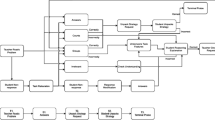Abstract
We evaluated an intensive program in a simulated format for rapidly teaching a job skill to nonvocal adults with autism. Following baseline probes with a new work task of assembling mailing boxes at a publishing company, 3 supported workers individually received repeated teaching sessions at a simulated work site. All workers met criterion with 1 day of simulation teaching, with subsequent criterion level performance upon returning to the job (1 worker required booster trials). Intensive teaching did not occasion problem behavior nor unhappiness indices. Improved work performance also occurred with two generalization tasks involving different materials. Implications for practitioners focus on improving worker performance without interfering with work completion that often accompanies on-the-job training. Potential applications of intensive programs for rapidly teaching other skills are discussed.
Similar content being viewed by others
References
Azrin, N. H., & Armstrong, P. M. (1973). The “mini-meal” — A method for teaching eating skills to the profoundly retarded. Mental Retardation, 11, 9–11.
Azrin, N. H., & Foxx, R. M. (1971). A rapid method of toilet training the institutionalized retarded. Journal of Applied Behavior Analysis, 4, 89–99.
Azrin, N. H., Schaeffer, R. M., & Wesolowski, M. D. (1976). A rapid method of teaching profoundly retarded persons to dress by a reinforcement-guidance method. Mental Retardation, 14, 29–33.
Cimera, R. E. (2006). The monetary benefits and costs of hiring supported employees: Revisited. Journal of Vocational Rehabilitation, 24, 137–144.
Conley, R. W. (2007). Maryland issues in supported employment. Journal of Vocational Rehabilitation, 26, 115–121.
Davis, P. K., Young, A., Cherry, H., Dahman, D., & Rehfeldt, R. A. (2004). Increasing the happiness of individuals with profound multiple disabilities: Replication and extension. Journal of Applied Behavior Analysis, 37, 531–534.
Garcia-Iriarte, E., Balcazar, F., & Taylor-Ritzler, T. (2007). Analysis of case managers’ support of youth with disabilities transitioning from school to work. Journal of Vocational Rehabilitation, 26, 129–140.
Green, C. W., & Reid, D. H. (1996). Defining, validating, and increasing indices of happiness among people with profound multiple disabilities. Journal of Applied Behavior Analysis, 29, 67–68.
Green, C. W., Reid, D. H., Rollyson, J. H., & Passante, S. C. (2005). An enriched teaching program for reducing resistance and indices of unhappiness among individuals with profound multiple disabilities. Journal of Applied Behavior Analysis, 38, 221–233.
Ivancic, M. T., Barrett, G. T., Simonow, A., & Kimberly, A. (1997). A replication to increase happiness indices among some people with profound multiple disabilities. Research in Developmental Disabilities, 18, 79–89.
Koegel, R. L., Openden, D., Fredeen, R., & Koegel, L. K. (2006). The basics of pivotal response treatment. In R. L. Koegel & L. K. Koegel (Eds.), Pivotal response treatments for autism: Communication, social, & academic development (pp. 4–30). Baltimore: Paul H. Brookes.
Lattimore, L. P., Parsons, M. B., & Reid, D. H. (2006). Enhancing job-site training of supported workers with autism: A re-emphasis on simulation. Journal of Applied Behavior Analysis, 39, 91–102.
Lattimore, L. P., Parsons, M. B., & Reid, D. H. (2008). Simulation training of community job skills for adults with autism: A further analysis. Behavior Analysis in Practice, 1, 24–29.
Lattimore, L. P., Reid, D. H., & Parsons, M. B. (2009). Individualizing indices of happiness and unhappiness for nonvocal adults with autism: Potential targets for behavioral assessment and intervention. Manuscript submitted for publication.
Libby, M. E., Weiss, J. S., Bancroft, S., & Ahearn, W. H. (2008). A comparison of most-to-least and least-to-most prompting on the acquisition of solitary play skills. Behavior Analysis in Practice, 1, 37–43.
Miltenberger, R. G. (2006). Antecedent interventions for challenging behaviors maintained by escape from instructional activities. In J. K. Luiselli (Ed.), Antecedent assessment & intervention: Supporting children & adults with developmental disabilities in community settings (pp. 101–124). Baltimore: Paul H. Brookes.
Parsons, M. B., Reid, D. H., Towery, D., England, P., & Darden, M. (2008). Remediating minimal progress on teaching programs by adults with severe disabilities in a congregate day setting. Behavior Analysis in Practice, 1, 59–67.
Powers, M. D. (2000). What is autism? In M. D. Powers (Ed.), Children with autism: A parents’ guide (pp. 1–44). Bethesda, MD: Woodbine House.
Reid, D. H., & Green, C. W. (2006). Life enjoyment, happiness, & antecedent support. In J. K. Luiselli (Ed.), Antecedent assessment & intervention: Supporting children & adults with developmental disabilities in community settings (pp. 249–268). Baltimore: Paul H. Brookes.
Reid, D. H., Green, C. W., & Parsons, M. B. (1998). A comparison of supported work versus center-based program services on selected outcomes for individuals with multiple severe disabilities. Journal of The Association for Persons with Severe Handicaps, 23, 69–76.
Sulzer-Azaroff, B., Pollack, M. J., Hamad, C., & Howley, T. (1998). Promoting widespread, durable service quality via interlocking contingencies. Research in Developmental Disabilities, 19, 39–61.
Wehman, P., Brooke, V. A., & Revell, W. G. (2007). Inclusive employment: Rolling back segregation of people with disabilities. In P. Wehman, K. J. Inge, W. G. Revell, & V. A. Brooke (Eds.), Real work for real pay: Inclusive employment for people with disabilities (pp. 3–18). Baltimore: Paul H. Brookes.
Wehman, P., Inge, K. J., Revell, W. G., & Brooke, V. A. (2007). Supported employment and work place supports: Overview and background. In P. Wehman, K. J. Inge, W. G. Revell, & V. A. Brooke (Eds.), Real work for real pay: Inclusive employment for people with disabilities (pp. 117–138). Baltimore: Paul H. Brookes.
White, J., & Weiner, J. S. (2004). Influence of least restrictive environment and community based training on integrated employment outcomes for transitioning students with severe disabilities. Journal of Vocational Rehabilitation, 21, 149–156.
Williams, W. L., DiVittorio, T., & Hausherr, L. (2002). A description and extension of a human services management model. Journal of Organizational Behavior Management, 22, 47–71.
Author information
Authors and Affiliations
Rights and permissions
About this article
Cite this article
Lattimore, L.P., Parsons, M.B. & Reid, D.H. Rapid Training of a Community Job Skill to Nonvocal Adults with Autism: An Extension of Intensive Teaching. Behav Analysis Practice 2, 34–42 (2009). https://doi.org/10.1007/BF03391735
Published:
Issue Date:
DOI: https://doi.org/10.1007/BF03391735




